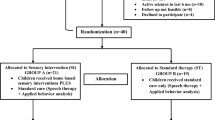Abstract
Objective
To present a model for autism showing that impairment of sensory and self-regulation is the core deficit that underlies delays in social/language skills and abnormal behavior in autism; and to demonstrate the efficacy of a treatment for autism based on Chinese medicine.
Methods
Children with autism under 6 years of age were assigned to treatment or wait-list conditions. A total of 130 children were treated and the results compared with 45 wait-list controls. Treatment is a tuina methodology directed at sensory impairment—Kai Qiao Tuina. The treatment was a five-month protocol that was implemented daily by trained parents via trained support staff. The effects of treatment on the main symptoms, autistic behavior, social/language delay, sensory and self-regulatory impairment, as well as on parenting stress, were observed and compared.
Results
The treatment had a large effect size (P<0.0001) on measures of sensory and self-regulation. The evaluations done by pre-school teachers demonstrated improvement in the measures of autism (P<0.003), and were confirmed by evaluations done by parents (P<0.0001). There was a large decrease (P<0.0001) in parenting stress.
Conclusions
Sensory and self-regulatory impairment is a main factor in the development and severity of autism. Treatment of young children with autism with Kai Qiao Tuina resulted in a decrease in sensory and self-regulatory impairment and a reduction in severity of measures of autism.
Similar content being viewed by others
References
Silva LMT, Schalock M, Ayres R, Bunse C, Budden S. Qigong massage treatment for sensory and self-regulation problems in young children with autism: a randomized controlled trial. Am J Occup Ther 2009;63:423–432.
Silva LMT, Schalock M, Gabrielsen K. The QST home program: RCT of a parent-delivered treatment for autism. Am J Occup Ther (in press).
Porges SW. The vagus: a mediator of behavioral and visceral features associated with autism. In: Bauman ML and Kemper TL, eds. The neurobiology of autism. Baltimore, MD: Johns Hopkins University Press; 2004:65–78.
Silva LMT, Cignolini A, Warren R, Skowron-Gooch A, Budden S. Improvement in sensory impairment and social development in young children with autism following an original qigong massage methodology. Am J Chin Med 2007;35:393–406.
Silva LMT, Ayres R, Schalock M. Outcomes of a pilot training program in a qigong massage intervention for young children with autism. Am J Occup Ther 2008;62:530–538.
Sparrow S, Cicchetti D, Balla D. Vineland adaptive behavior scales (interview edition). Circle Pines, MN: American Guidance Service, 2005.
Krug D, Arick J, Almond P. Behavior checklist for identifying severely handicapped individuals with high levels of autistic behavior. J Child Psychol Psychiatry 1980;2:221–229.
Krug D, Arick J, Almond P. Autism screening instrument for educational planning. Austin, TX: Pro-Ed, 1993:56–64.
Dunn W. Sensory profile user’s manual. San Antonio, TX: Psychological Corporation; 1999.
Cohen IL, Sudhalter V. PDD behavior inventory. Lutz, FL: Psychological Assessment Resources; 2005.
Porges S, Bohrer, R, eds. The analysis of periodic processes in psychophysiological research. In: Cacioppo J, Tassinary I, eds. Principles of psychophysiology: physical, social, and inferential elements. New York: Cambridge University Press; 1990:708–753.
Silva LMT, Schalock M. Sensory and Self-Regulation Checklist: initial psychometric evidence and findings. Am J Occup Ther (in press).
Haase RF. Classical and partial eta square in multifactor ANOVA designs. Educ Psychol Meas 1983;43:35–39.
Hedges LV. Statistical methodology in meta-analysis. Princeton, NJ: Educational Testing Service; 1982:251–265.
Cohen J. Statistical power analysis for the behavioral sciences. 2nd ed. Hillsdale, NJ: Lawrence Erlbaum; 1988:345–387.
Schuirmann D. On hypothesis testing to determine if the mean of the normal distribution is contained in a known interval. Biometrics 1981;37:617.
Schuirmann D. A comparison of the two one-sided procedure and the power approach for assessing the equivalence of average bioavailability. J Pharmacokinet Biopharm 1987;15:657–680.
Kline RB. Beyond significance testing: reforming data analysis methods in behavioral research. Washington, D.C.: American Psychological Association; 2004:264–288.
American Psychiatric Association. Diagnostic and statistical manual of mental disorders. 4th ed. Washington DC: American Psychiatric Association; 1994:69–70.
Leekam SR, Libby SJ, Wing L, Gould J. Describing the sensory abnormalities of children and adults with autism. J Autism Dev Disord 2007;37:894–910.
Levy SE, Mandell DS, Schultz RT. Autism. Lancet 2009;374:1627–1638.
Killackey HP, Rhoades RW, Bennett-Clarke CA. The formation of a cortical somatotopic map. Trends Neurosci 1995;18:402–407.
Killackey HP, Ivy GO, Cunningham TJ. Anomalous organization of the SMI somatotopic map consequent to vibrissae removal in the newborn rat. Brain Res 1978;155:136–140.
Longo MR, Azanon E, Haggard P. More than skin deep: body representation beyond primary somatosensory cortex. Neuropsychologia 2010;48:655–668.
Author information
Authors and Affiliations
Corresponding author
Additional information
Supported by the Curry Stone Foundation, Spririt Moutain Community Fund, and Northwest Health Foundation
Rights and permissions
About this article
Cite this article
Silva, L.M.T., Schalock, M. & Ayres, R. A model and treatment for autism at the convergence of Chinese medicine and Western science: First 130 cases. Chin. J. Integr. Med. 17, 421–429 (2011). https://doi.org/10.1007/s11655-011-0635-0
Received:
Published:
Issue Date:
DOI: https://doi.org/10.1007/s11655-011-0635-0




